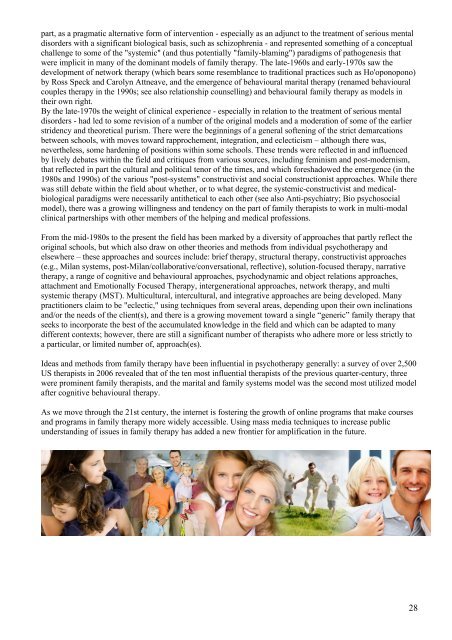FAMILY THERAPY - DEAN AMORY
This is the new, extended and improved version of “An Introduction to Family Therapy”, your reference guide containing detailed information about all important facets of family therapy: schools and methods, strategies used, structure and content of family therapy sessions, stages, basic techniques, influential people, history of family therapy,… Since I feel many people will benefit and appreciate being allowed easy access to this kind of information ordered in short, easily accessible chapters, I decided to make this compilation work - based on information freely available in the public domain -, available for free to everybody as a download file. ----//---- The cover illustration is from Zirta from Mexico: www.zirta.net - email address: beatriz@zirta.net
This is the new, extended and improved version of “An Introduction to Family Therapy”, your reference guide containing detailed information about all important facets of family therapy: schools and methods, strategies used, structure and content of family therapy sessions, stages, basic techniques, influential people, history of family therapy,… Since I feel many people will benefit and appreciate being allowed easy access to this kind of information ordered in short, easily accessible chapters, I decided to make this compilation work - based on information freely available in the public domain -, available for free to everybody as a download file.
----//----
The cover illustration is from Zirta from Mexico: www.zirta.net - email address: beatriz@zirta.net
Create successful ePaper yourself
Turn your PDF publications into a flip-book with our unique Google optimized e-Paper software.
part, as a pragmatic alternative form of intervention - especially as an adjunct to the treatment of serious mental<br />
disorders with a significant biological basis, such as schizophrenia - and represented something of a conceptual<br />
challenge to some of the "systemic" (and thus potentially "family-blaming") paradigms of pathogenesis that<br />
were implicit in many of the dominant models of family therapy. The late-1960s and early-1970s saw the<br />
development of network therapy (which bears some resemblance to traditional practices such as Ho'oponopono)<br />
by Ross Speck and Carolyn Attneave, and the emergence of behavioural marital therapy (renamed behavioural<br />
couples therapy in the 1990s; see also relationship counselling) and behavioural family therapy as models in<br />
their own right.<br />
By the late-1970s the weight of clinical experience - especially in relation to the treatment of serious mental<br />
disorders - had led to some revision of a number of the original models and a moderation of some of the earlier<br />
stridency and theoretical purism. There were the beginnings of a general softening of the strict demarcations<br />
between schools, with moves toward rapprochement, integration, and eclecticism – although there was,<br />
nevertheless, some hardening of positions within some schools. These trends were reflected in and influenced<br />
by lively debates within the field and critiques from various sources, including feminism and post-modernism,<br />
that reflected in part the cultural and political tenor of the times, and which foreshadowed the emergence (in the<br />
1980s and 1990s) of the various "post-systems" constructivist and social constructionist approaches. While there<br />
was still debate within the field about whether, or to what degree, the systemic-constructivist and medicalbiological<br />
paradigms were necessarily antithetical to each other (see also Anti-psychiatry; Bio psychosocial<br />
model), there was a growing willingness and tendency on the part of family therapists to work in multi-modal<br />
clinical partnerships with other members of the helping and medical professions.<br />
From the mid-1980s to the present the field has been marked by a diversity of approaches that partly reflect the<br />
original schools, but which also draw on other theories and methods from individual psychotherapy and<br />
elsewhere – these approaches and sources include: brief therapy, structural therapy, constructivist approaches<br />
(e.g., Milan systems, post-Milan/collaborative/conversational, reflective), solution-focused therapy, narrative<br />
therapy, a range of cognitive and behavioural approaches, psychodynamic and object relations approaches,<br />
attachment and Emotionally Focused Therapy, intergenerational approaches, network therapy, and multi<br />
systemic therapy (MST). Multicultural, intercultural, and integrative approaches are being developed. Many<br />
practitioners claim to be "eclectic," using techniques from several areas, depending upon their own inclinations<br />
and/or the needs of the client(s), and there is a growing movement toward a single “generic” family therapy that<br />
seeks to incorporate the best of the accumulated knowledge in the field and which can be adapted to many<br />
different contexts; however, there are still a significant number of therapists who adhere more or less strictly to<br />
a particular, or limited number of, approach(es).<br />
Ideas and methods from family therapy have been influential in psychotherapy generally: a survey of over 2,500<br />
US therapists in 2006 revealed that of the ten most influential therapists of the previous quarter-century, three<br />
were prominent family therapists, and the marital and family systems model was the second most utilized model<br />
after cognitive behavioural therapy.<br />
As we move through the 21st century, the internet is fostering the growth of online programs that make courses<br />
and programs in family therapy more widely accessible. Using mass media techniques to increase public<br />
understanding of issues in family therapy has added a new frontier for amplification in the future.<br />
28


















